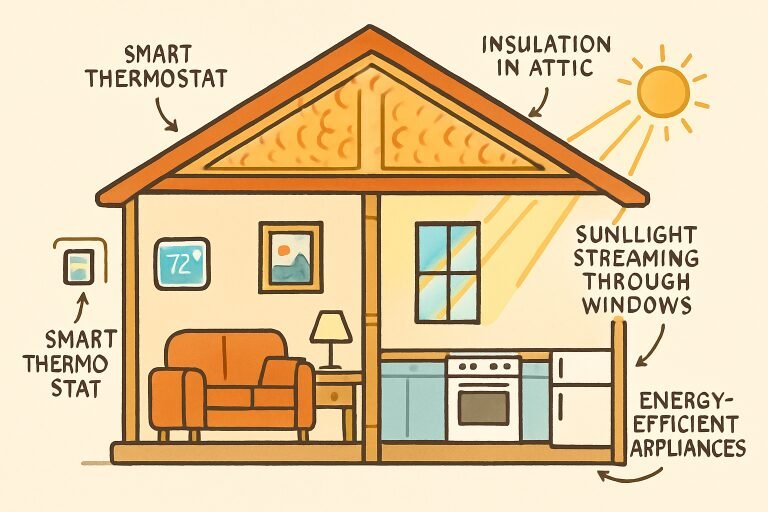Key Takeaways
- Modern HVAC upgrades significantly reduce energy consumption compared to outdated systems.
- Smart, programmable thermostats tailor heat schedules for optimal efficiency and comfort.
- Sealing leaks and upgrading insulation delivers substantial, low-cost energy savings.
- Integrating passive heat sources and efficient appliances multiplies benefits.
With energy bills climbing and the desire for eco-friendly homes stronger than ever, finding new ways to keep your home warm without breaking the bank is top of mind for many. Thoughtful, innovative solutions don’t just bring comfort—they’re an investment in lower operating costs and a sustainable future. For those considering upgrades or essential replacements, exploring options for furnace replacement can be a strategic move to improve efficiency and slash bills.
Fortunately, a mix of advanced technologies and practical home improvements can significantly boost your heating efficiency. From smart thermostats to simple weatherproofing fixes, these strategies make your home both more efficient and more innovative—potentially saving you hundreds of dollars every year while reducing your carbon footprint.
Upgrade to High-Efficiency HVAC Components
If you haven’t upgraded your heating system in a decade or more, you’re likely missing out on significant efficiency gains. Newer HVAC systems, equipped with advanced heat exchangers, variable-speed motors, and zone controls, use significantly less energy than their older counterparts. According to the Department of Energy, replacing an outdated heating unit with a high-efficiency model can yield energy savings of up to 20-30%. These modern systems also tend to run quieter and maintain more consistent temperatures, enhancing your day-to-day comfort. In particular, variable speed furnaces and heat pumps dynamically adjust their output based on your home’s actual needs, whereas older units simply cycle on and off at full blast.
Install a Smart Thermostat
Smart thermostats are among the simplest tools for more innovative energy use. By learning your family’s routines and adjusting temperatures during the day or night, a programmable or smart thermostat can help you save without sacrificing comfort. The U.S. Department of Energy notes that households that lower the thermostat 7-10°F for eight hours a day can trim annual heating bills by as much as 10%. Top models today even allow you to control schedules remotely via your phone, adapting to travel plans or weather swings with a tap.
Seal Drafts and Improve Insulation
Heat escapes rapidly through cracks, gaps, or thin insulation. Start by inspecting windows, doors, and attic hatches for drafts—a simple tube of caulk or a roll of weatherstripping can make a world of difference. Upgrading attic or wall insulation, meanwhile, is one of the most cost-effective measures you can take. According to ENERGY STAR, proper sealing and insulation can reduce your heating and cooling bills by about 15%. Invest in insulation that is suitable for your climate, and don’t forget to insulate floors over unheated spaces.
Maximize Natural Heat Sources
The sun provides free heat. Open curtains and blinds during the day, especially on south-facing windows, to let solar energy naturally warm your home. Conversely, close them at dusk to retain the heat you’ve gained. Simple yet effective, this no-cost solution reduces the workload on your furnace or heat pump, especially during sunny winter days. It’s also worth paying attention to landscaping—deciduous trees can offer shade in summer while allowing sunlight to penetrate in winter months.
Use Energy-Efficient Appliances
Replacing aging appliances—including water heaters, washers, and dryers—with ENERGY STAR-certified options is a direct route to lower consumption. The EPA estimates that these efficient appliances collectively save homeowners thousands over their lifetimes and reduce greenhouse gas emissions by 130,000 pounds per household. Even more minor swaps (like switching to LED light bulbs) can add up, making every room in your home less wasteful and more affordable.

Consider Radiator Reflector Foil
If your home uses radiators, installing reflector foil behind them directs heat back into the living space rather than losing it through the walls. This fix is inexpensive, easy enough for a DIYer, and can noticeably improve the effectiveness of every hour your system runs. It’s beneficial for radiators on exterior walls and often overlooked in whole-home efficiency upgrades.
Explore Federal Assistance Programs
For eligible households, the Low-Income Home Energy Assistance Program (LIHEAP) offers assistance with winter heating bills. Programs like this can provide a safety net, ensuring no one has to choose between staying warm and meeting other essential needs. Check your state’s guidelines, as availability and qualification criteria vary locally.
Conclusion
Implementing these innovative strategies creates a home that’s not only warm and inviting but also economical to run year after year. By combining modern heating technology, strategic upgrades, and resourceful habits, you’ll enjoy a comfortable home and the peace of mind that comes from knowing you’re saving energy and money—every season. Start with one improvement and build from there; each step brings you closer to a smarter, more efficient home.

